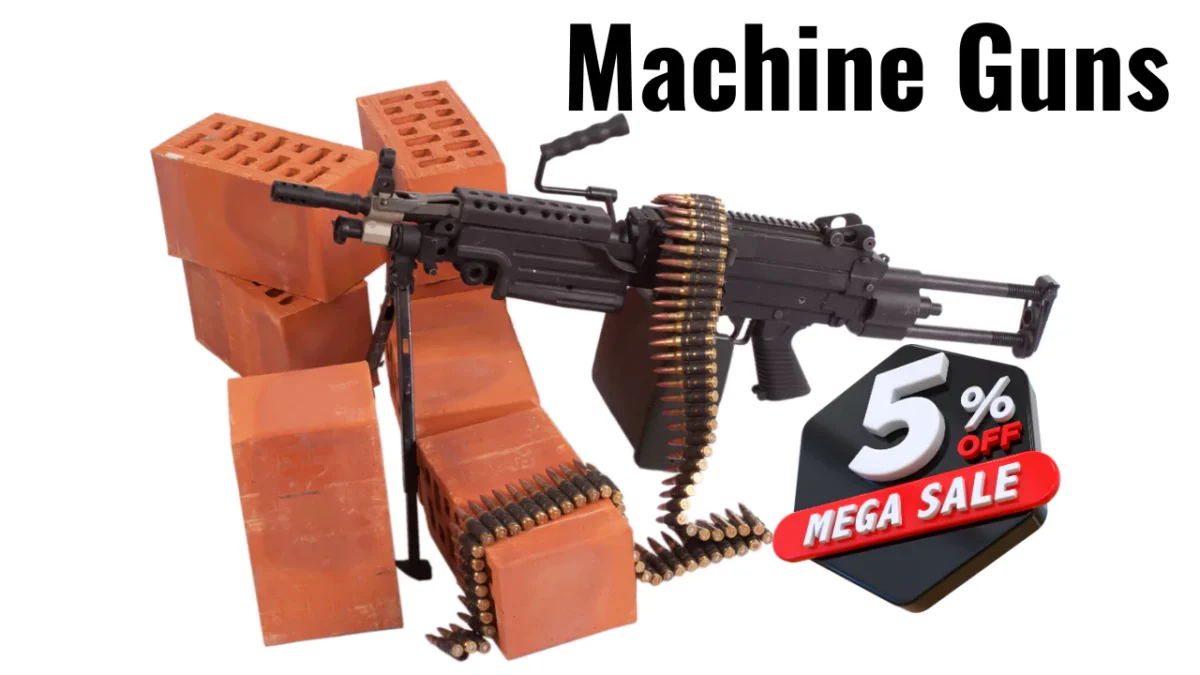Machine Guns | Sub Machine Guns | Light Machine Guns
A machine gun is a fully automatic firearm capable of firing bullets in rapid succession from an ammunition belt or magazine. They are distinguished by their high rate of fire, typically several hundred rounds per minute.
-
Categories: Machine guns are classified into submachine, machine, and autocannons. Submachine guns are handheld automatic weapons firing pistol-caliber rounds. Machine guns, on the other hand, are typically mounted or fired from a bipod and fire rifle cartridges. Autocannons are larger-caliber guns firing rounds larger than 16 mm.
-
Portability: While machine guns are generally portable to some extent, they are often used when attached to a mount or fired from a stable position, such as the ground with a bipod. Light machine guns are designed to be handheld but are more effective when fired from a prone position due to their larger size and weight than submachine guns.
Machine Guns—Past, Present, And Future
-
Invention and Early Use Of Machine Guns: Hiram Maxim invented the world’s first fully automated machine guns in 1883, which saw action in conflicts such as the Second Boer War and the Russo-Japanese War.
-
Machine Guns In World War I: Machine guns became a standard issue in World War I, used by forces on all sides for ground and anti-aircraft warfare. Maxims, Browning M1919s, and Hotchkiss guns were among the most widely used models.
-
Interwar Period: Between the World Wars, large-caliber machine guns emerged, such as the Browning M2 and the Soviet DShK-12.7mm. Germany introduced the Mg34 and Mg42, setting the trend for versatile machine guns that could be used as light or heavy weapons.
-
Machine Guns Modern Role: Today, machine guns provide sustained firepower against enemy soldiers and unarmored targets. Heavy machine guns (.50/12.7mm) can also engage lightly armored targets like APCs and helicopters.
-
Deployment: Infantry squads worldwide typically have at least one light machine gun, such as the RPK-74 or M249 SAW. Medium machine guns are often mounted on vehicles or used on ground mounts at troop and company levels. Heavy machine guns serve various roles, including anti-aircraft defense and support weapons for infantry units.
-
Machine Gun Barrel Interchangeability: Many machine guns feature quickly interchangeable barrels, allowing sustained fire without overheating. Intensive firing can lead to barrel overheating, affecting accuracy and lifespan.
-
Significance of Machine Guns: Machine guns represent the pinnacle of concentrated firepower in modern warfare and gradually supplanted individual shoulder rifles. The Garand rifle and the newly adopted light carbine are in the early stages of this transition.
-
Early Firearms: Weapons resembling machine guns, such as the organ gun and ribaudequin, were used in European warfare around the time of the discovery of America. These consisted of multiple arquebus barrels mounted on carriages and fired rapidly by a crew.
-
Limitations of Early Firearms: While effective in repelling sudden attacks, early firearms had drawbacks such as slow reloading times and vulnerability during reloading. Multiple gun configurations, like the Billinghurst and Requa “battery” used in the Civil War, attempted to address these issues.
-
Billinghurst and Requa Gun: This gun, with 24 rifle barrels mounted on a carriage, allowed for simultaneous loading of all barrels using clips. However, it quickly became obsolete with the advent of true machine-operated rapid-fire guns enabled by metallic cartridges.
-
Early Patent on a Machine Gun: The earliest patent for a machine gun was granted in 1718 to James Puckle of London. Puckle referred to his invention as a “Defense,” indicating its potential offensive and defensive capabilities.



Write a comment
Your email address will not be published. All fields are required